In-depth Analysis of Theories, Principles, and Models in Education
VerifiedAdded on 2023/06/10
|19
|6140
|485
Report
AI Summary
This report provides a comprehensive analysis of various theories, models, and principles relevant to education and training, focusing on learning, communication, assessment, curriculum development, and reflection & evaluation. It explores behaviorism and cognitivism theories, VARK and Honey & Mumford learning preference models, Piaget and Bernstein communication theories, and Shannon & Weaver's communication model. The report also discusses the application of these theories and models in teaching, learning, and assessment practices, emphasizing the importance of individual learning preferences and inclusive teaching strategies. Furthermore, it examines curriculum development theories and reflection models, highlighting their role in reviewing and improving teaching practices, particularly in specialized areas like English grammar. The aim is to provide educators and learners with a deeper understanding of these concepts and their practical implications in enhancing the educational experience.
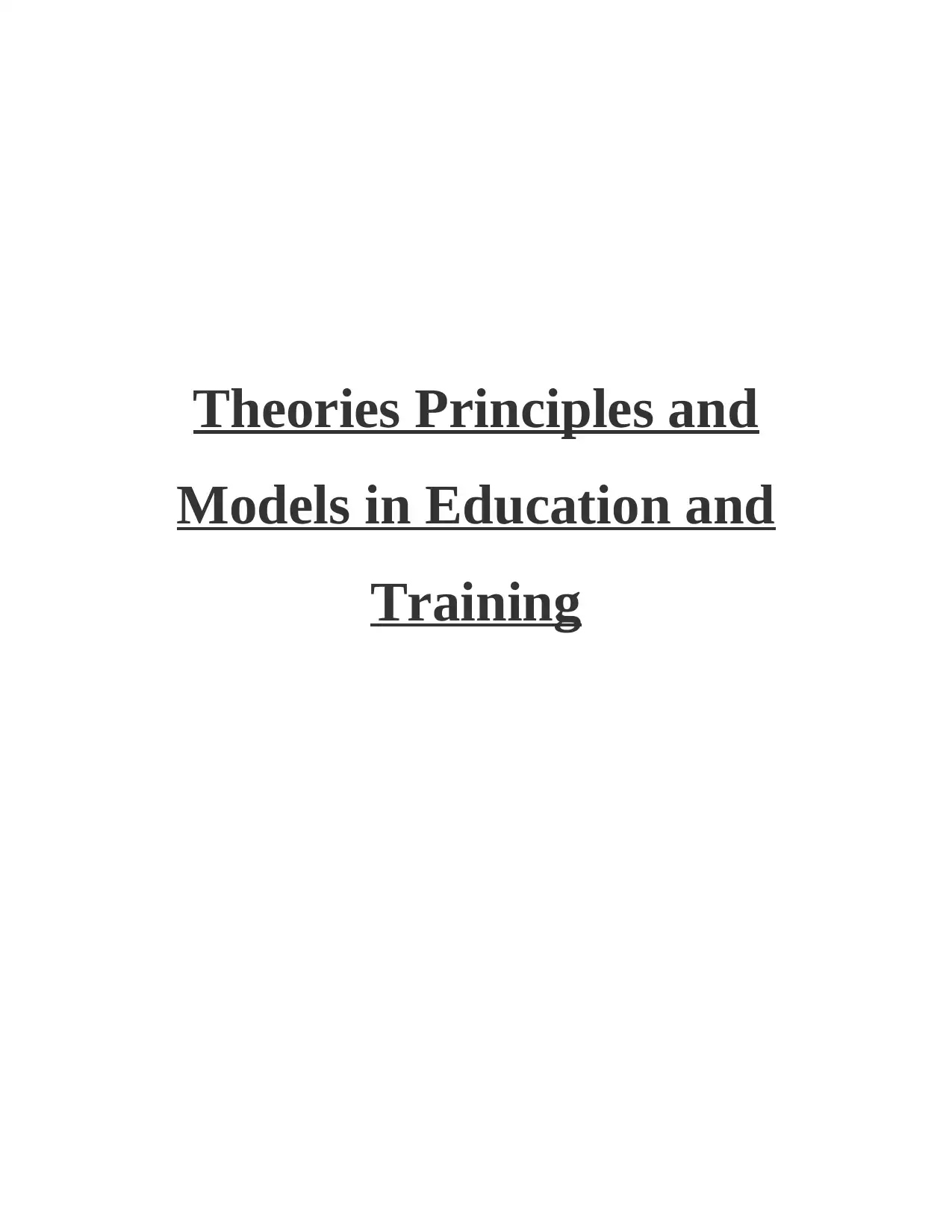
Theories Principles and
Models in Education and
Training
Models in Education and
Training
Paraphrase This Document
Need a fresh take? Get an instant paraphrase of this document with our AI Paraphraser
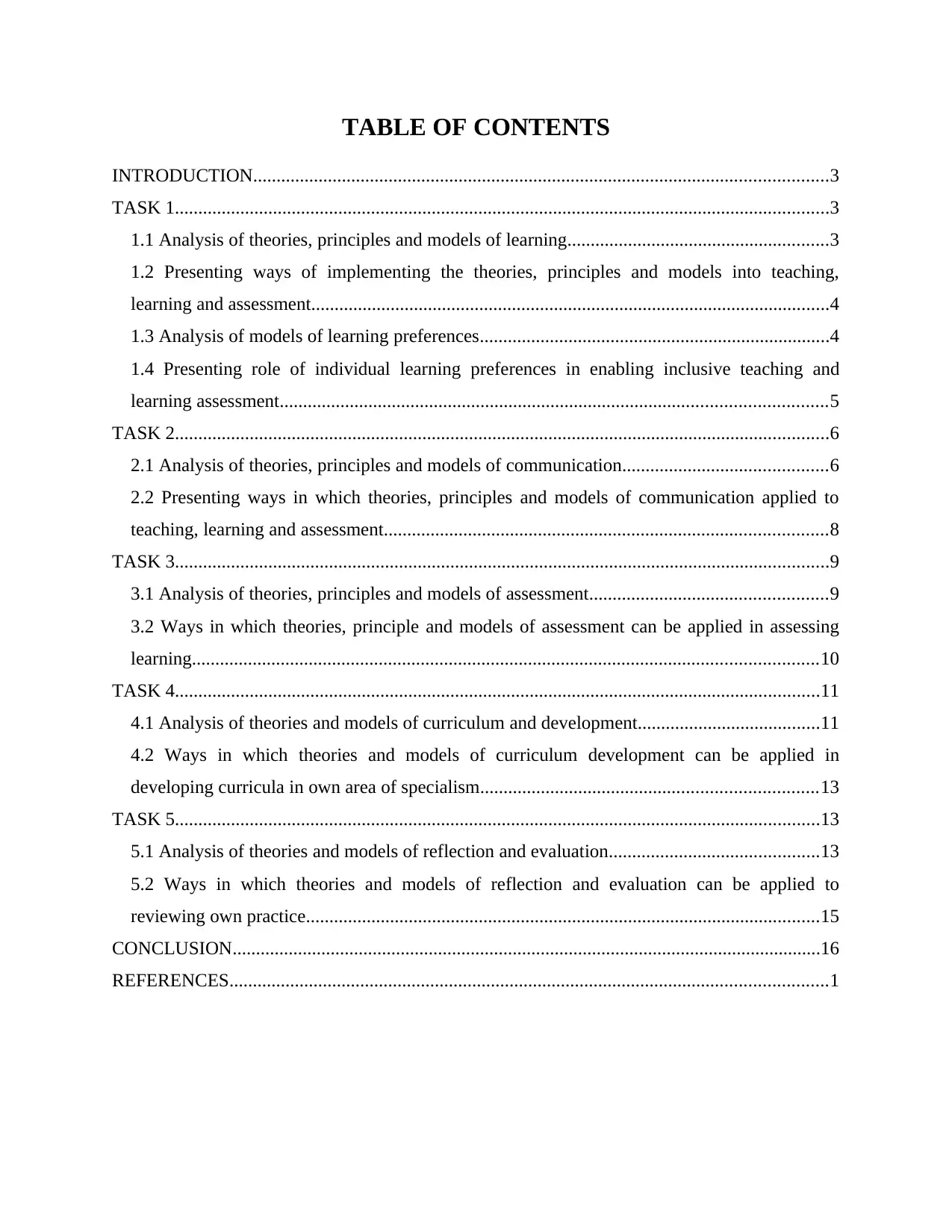
TABLE OF CONTENTS
INTRODUCTION...........................................................................................................................3
TASK 1............................................................................................................................................3
1.1 Analysis of theories, principles and models of learning........................................................3
1.2 Presenting ways of implementing the theories, principles and models into teaching,
learning and assessment...............................................................................................................4
1.3 Analysis of models of learning preferences...........................................................................4
1.4 Presenting role of individual learning preferences in enabling inclusive teaching and
learning assessment.....................................................................................................................5
TASK 2............................................................................................................................................6
2.1 Analysis of theories, principles and models of communication............................................6
2.2 Presenting ways in which theories, principles and models of communication applied to
teaching, learning and assessment...............................................................................................8
TASK 3............................................................................................................................................9
3.1 Analysis of theories, principles and models of assessment...................................................9
3.2 Ways in which theories, principle and models of assessment can be applied in assessing
learning......................................................................................................................................10
TASK 4..........................................................................................................................................11
4.1 Analysis of theories and models of curriculum and development.......................................11
4.2 Ways in which theories and models of curriculum development can be applied in
developing curricula in own area of specialism........................................................................13
TASK 5..........................................................................................................................................13
5.1 Analysis of theories and models of reflection and evaluation.............................................13
5.2 Ways in which theories and models of reflection and evaluation can be applied to
reviewing own practice..............................................................................................................15
CONCLUSION..............................................................................................................................16
REFERENCES................................................................................................................................1
INTRODUCTION...........................................................................................................................3
TASK 1............................................................................................................................................3
1.1 Analysis of theories, principles and models of learning........................................................3
1.2 Presenting ways of implementing the theories, principles and models into teaching,
learning and assessment...............................................................................................................4
1.3 Analysis of models of learning preferences...........................................................................4
1.4 Presenting role of individual learning preferences in enabling inclusive teaching and
learning assessment.....................................................................................................................5
TASK 2............................................................................................................................................6
2.1 Analysis of theories, principles and models of communication............................................6
2.2 Presenting ways in which theories, principles and models of communication applied to
teaching, learning and assessment...............................................................................................8
TASK 3............................................................................................................................................9
3.1 Analysis of theories, principles and models of assessment...................................................9
3.2 Ways in which theories, principle and models of assessment can be applied in assessing
learning......................................................................................................................................10
TASK 4..........................................................................................................................................11
4.1 Analysis of theories and models of curriculum and development.......................................11
4.2 Ways in which theories and models of curriculum development can be applied in
developing curricula in own area of specialism........................................................................13
TASK 5..........................................................................................................................................13
5.1 Analysis of theories and models of reflection and evaluation.............................................13
5.2 Ways in which theories and models of reflection and evaluation can be applied to
reviewing own practice..............................................................................................................15
CONCLUSION..............................................................................................................................16
REFERENCES................................................................................................................................1
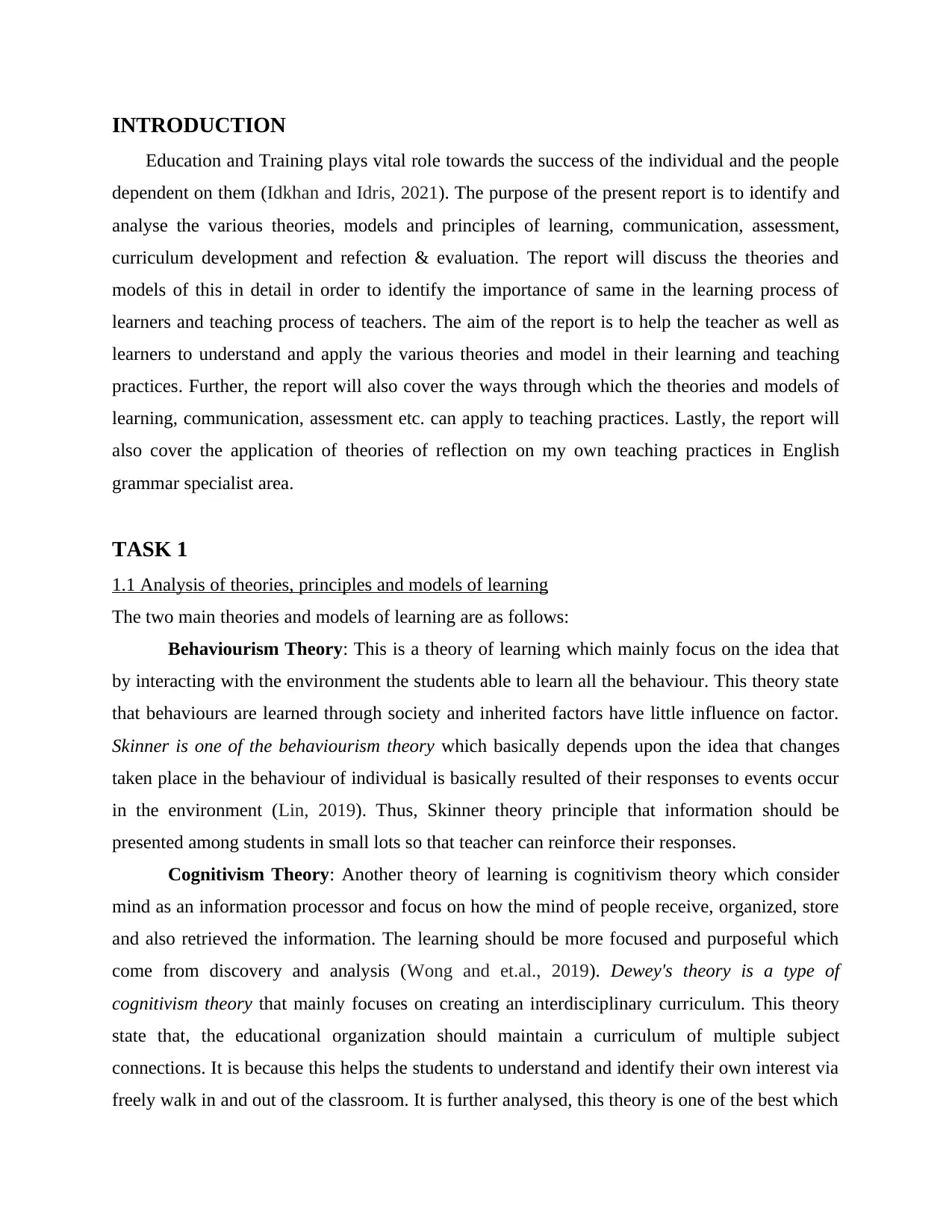
INTRODUCTION
Education and Training plays vital role towards the success of the individual and the people
dependent on them (Idkhan and Idris, 2021). The purpose of the present report is to identify and
analyse the various theories, models and principles of learning, communication, assessment,
curriculum development and refection & evaluation. The report will discuss the theories and
models of this in detail in order to identify the importance of same in the learning process of
learners and teaching process of teachers. The aim of the report is to help the teacher as well as
learners to understand and apply the various theories and model in their learning and teaching
practices. Further, the report will also cover the ways through which the theories and models of
learning, communication, assessment etc. can apply to teaching practices. Lastly, the report will
also cover the application of theories of reflection on my own teaching practices in English
grammar specialist area.
TASK 1
1.1 Analysis of theories, principles and models of learning
The two main theories and models of learning are as follows:
Behaviourism Theory: This is a theory of learning which mainly focus on the idea that
by interacting with the environment the students able to learn all the behaviour. This theory state
that behaviours are learned through society and inherited factors have little influence on factor.
Skinner is one of the behaviourism theory which basically depends upon the idea that changes
taken place in the behaviour of individual is basically resulted of their responses to events occur
in the environment (Lin, 2019). Thus, Skinner theory principle that information should be
presented among students in small lots so that teacher can reinforce their responses.
Cognitivism Theory: Another theory of learning is cognitivism theory which consider
mind as an information processor and focus on how the mind of people receive, organized, store
and also retrieved the information. The learning should be more focused and purposeful which
come from discovery and analysis (Wong and et.al., 2019). Dewey's theory is a type of
cognitivism theory that mainly focuses on creating an interdisciplinary curriculum. This theory
state that, the educational organization should maintain a curriculum of multiple subject
connections. It is because this helps the students to understand and identify their own interest via
freely walk in and out of the classroom. It is further analysed, this theory is one of the best which
Education and Training plays vital role towards the success of the individual and the people
dependent on them (Idkhan and Idris, 2021). The purpose of the present report is to identify and
analyse the various theories, models and principles of learning, communication, assessment,
curriculum development and refection & evaluation. The report will discuss the theories and
models of this in detail in order to identify the importance of same in the learning process of
learners and teaching process of teachers. The aim of the report is to help the teacher as well as
learners to understand and apply the various theories and model in their learning and teaching
practices. Further, the report will also cover the ways through which the theories and models of
learning, communication, assessment etc. can apply to teaching practices. Lastly, the report will
also cover the application of theories of reflection on my own teaching practices in English
grammar specialist area.
TASK 1
1.1 Analysis of theories, principles and models of learning
The two main theories and models of learning are as follows:
Behaviourism Theory: This is a theory of learning which mainly focus on the idea that
by interacting with the environment the students able to learn all the behaviour. This theory state
that behaviours are learned through society and inherited factors have little influence on factor.
Skinner is one of the behaviourism theory which basically depends upon the idea that changes
taken place in the behaviour of individual is basically resulted of their responses to events occur
in the environment (Lin, 2019). Thus, Skinner theory principle that information should be
presented among students in small lots so that teacher can reinforce their responses.
Cognitivism Theory: Another theory of learning is cognitivism theory which consider
mind as an information processor and focus on how the mind of people receive, organized, store
and also retrieved the information. The learning should be more focused and purposeful which
come from discovery and analysis (Wong and et.al., 2019). Dewey's theory is a type of
cognitivism theory that mainly focuses on creating an interdisciplinary curriculum. This theory
state that, the educational organization should maintain a curriculum of multiple subject
connections. It is because this helps the students to understand and identify their own interest via
freely walk in and out of the classroom. It is further analysed, this theory is one of the best which
⊘ This is a preview!⊘
Do you want full access?
Subscribe today to unlock all pages.

Trusted by 1+ million students worldwide
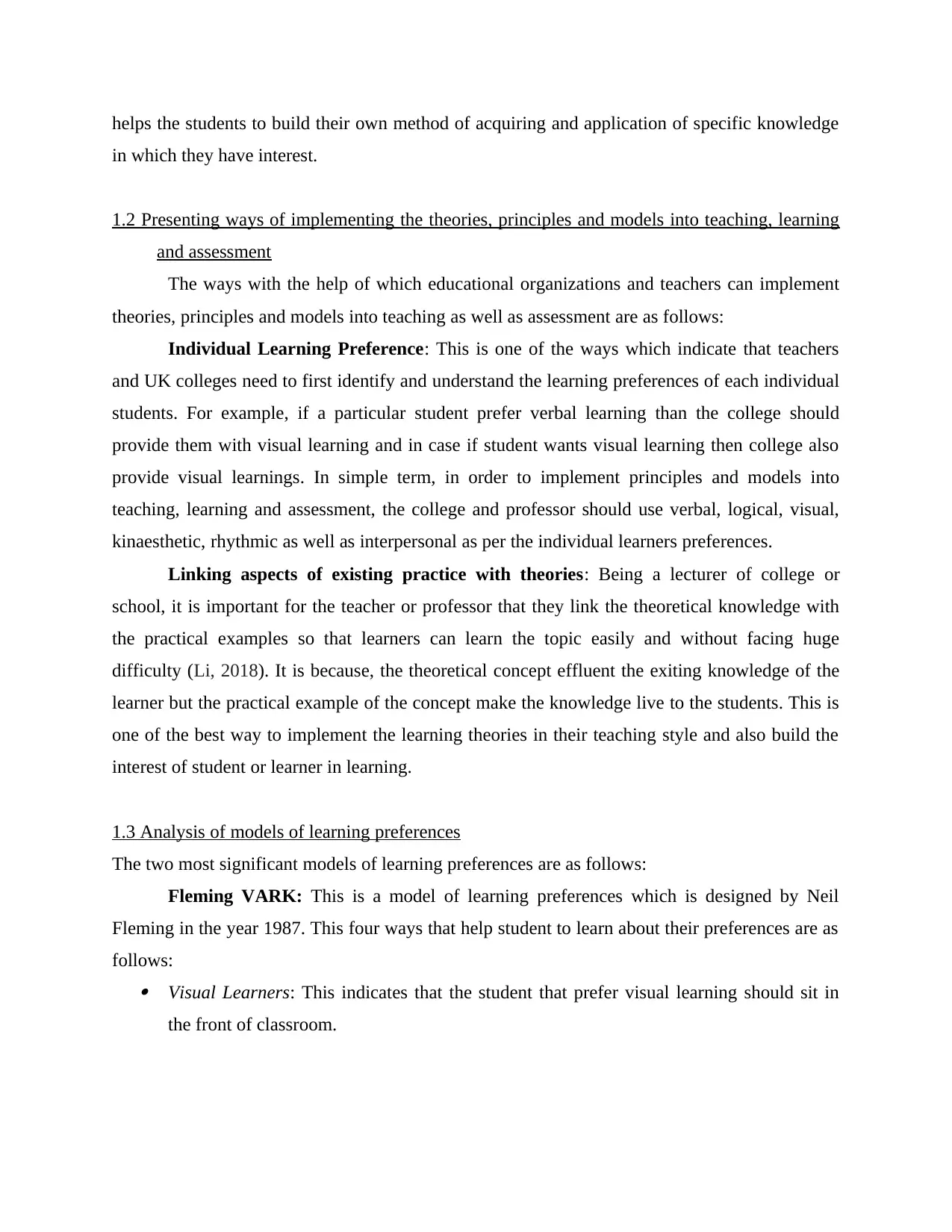
helps the students to build their own method of acquiring and application of specific knowledge
in which they have interest.
1.2 Presenting ways of implementing the theories, principles and models into teaching, learning
and assessment
The ways with the help of which educational organizations and teachers can implement
theories, principles and models into teaching as well as assessment are as follows:
Individual Learning Preference: This is one of the ways which indicate that teachers
and UK colleges need to first identify and understand the learning preferences of each individual
students. For example, if a particular student prefer verbal learning than the college should
provide them with visual learning and in case if student wants visual learning then college also
provide visual learnings. In simple term, in order to implement principles and models into
teaching, learning and assessment, the college and professor should use verbal, logical, visual,
kinaesthetic, rhythmic as well as interpersonal as per the individual learners preferences.
Linking aspects of existing practice with theories: Being a lecturer of college or
school, it is important for the teacher or professor that they link the theoretical knowledge with
the practical examples so that learners can learn the topic easily and without facing huge
difficulty (Li, 2018). It is because, the theoretical concept effluent the exiting knowledge of the
learner but the practical example of the concept make the knowledge live to the students. This is
one of the best way to implement the learning theories in their teaching style and also build the
interest of student or learner in learning.
1.3 Analysis of models of learning preferences
The two most significant models of learning preferences are as follows:
Fleming VARK: This is a model of learning preferences which is designed by Neil
Fleming in the year 1987. This four ways that help student to learn about their preferences are as
follows: Visual Learners: This indicates that the student that prefer visual learning should sit in
the front of classroom.
in which they have interest.
1.2 Presenting ways of implementing the theories, principles and models into teaching, learning
and assessment
The ways with the help of which educational organizations and teachers can implement
theories, principles and models into teaching as well as assessment are as follows:
Individual Learning Preference: This is one of the ways which indicate that teachers
and UK colleges need to first identify and understand the learning preferences of each individual
students. For example, if a particular student prefer verbal learning than the college should
provide them with visual learning and in case if student wants visual learning then college also
provide visual learnings. In simple term, in order to implement principles and models into
teaching, learning and assessment, the college and professor should use verbal, logical, visual,
kinaesthetic, rhythmic as well as interpersonal as per the individual learners preferences.
Linking aspects of existing practice with theories: Being a lecturer of college or
school, it is important for the teacher or professor that they link the theoretical knowledge with
the practical examples so that learners can learn the topic easily and without facing huge
difficulty (Li, 2018). It is because, the theoretical concept effluent the exiting knowledge of the
learner but the practical example of the concept make the knowledge live to the students. This is
one of the best way to implement the learning theories in their teaching style and also build the
interest of student or learner in learning.
1.3 Analysis of models of learning preferences
The two most significant models of learning preferences are as follows:
Fleming VARK: This is a model of learning preferences which is designed by Neil
Fleming in the year 1987. This four ways that help student to learn about their preferences are as
follows: Visual Learners: This indicates that the student that prefer visual learning should sit in
the front of classroom.
Paraphrase This Document
Need a fresh take? Get an instant paraphrase of this document with our AI Paraphraser
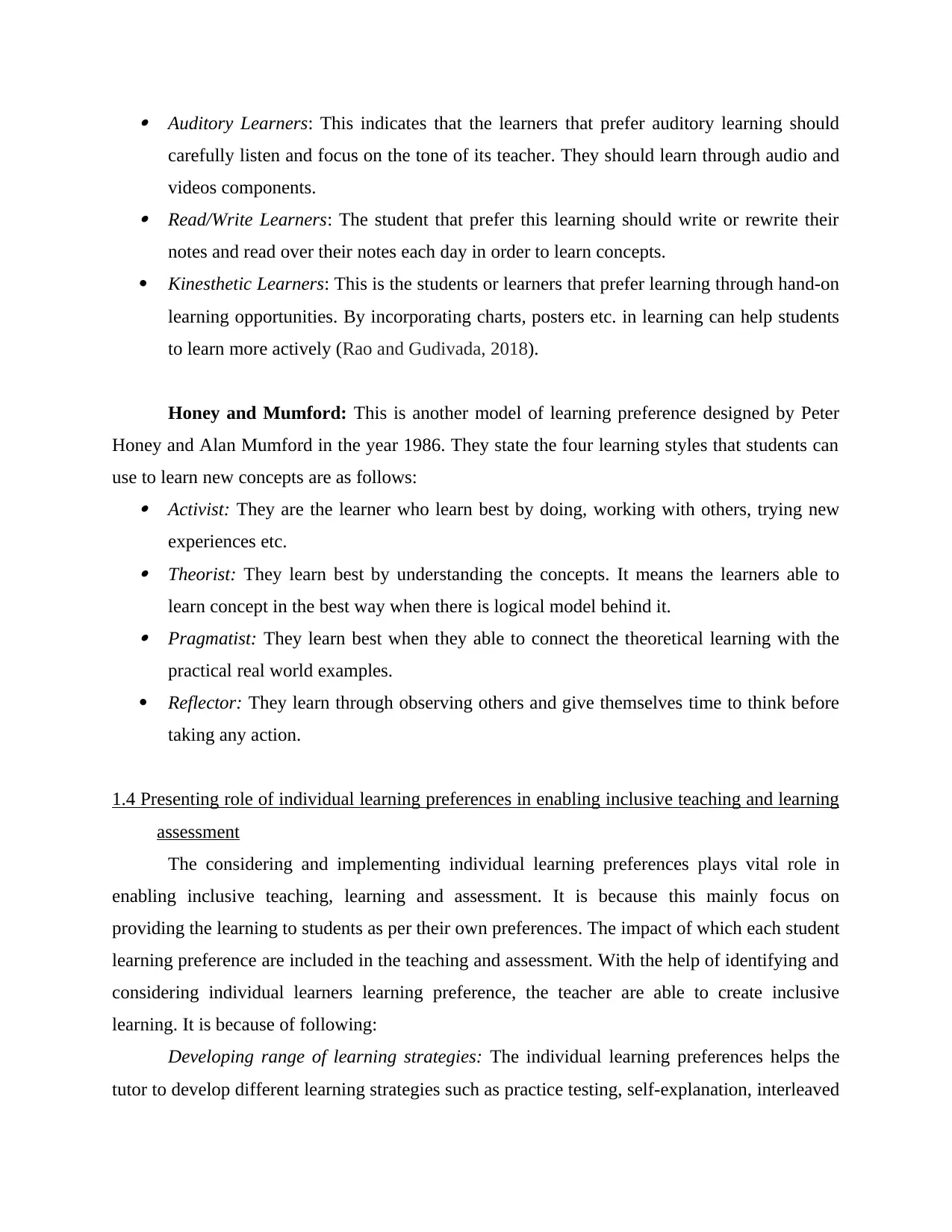
Auditory Learners: This indicates that the learners that prefer auditory learning should
carefully listen and focus on the tone of its teacher. They should learn through audio and
videos components. Read/Write Learners: The student that prefer this learning should write or rewrite their
notes and read over their notes each day in order to learn concepts.
Kinesthetic Learners: This is the students or learners that prefer learning through hand-on
learning opportunities. By incorporating charts, posters etc. in learning can help students
to learn more actively (Rao and Gudivada, 2018).
Honey and Mumford: This is another model of learning preference designed by Peter
Honey and Alan Mumford in the year 1986. They state the four learning styles that students can
use to learn new concepts are as follows: Activist: They are the learner who learn best by doing, working with others, trying new
experiences etc. Theorist: They learn best by understanding the concepts. It means the learners able to
learn concept in the best way when there is logical model behind it. Pragmatist: They learn best when they able to connect the theoretical learning with the
practical real world examples.
Reflector: They learn through observing others and give themselves time to think before
taking any action.
1.4 Presenting role of individual learning preferences in enabling inclusive teaching and learning
assessment
The considering and implementing individual learning preferences plays vital role in
enabling inclusive teaching, learning and assessment. It is because this mainly focus on
providing the learning to students as per their own preferences. The impact of which each student
learning preference are included in the teaching and assessment. With the help of identifying and
considering individual learners learning preference, the teacher are able to create inclusive
learning. It is because of following:
Developing range of learning strategies: The individual learning preferences helps the
tutor to develop different learning strategies such as practice testing, self-explanation, interleaved
carefully listen and focus on the tone of its teacher. They should learn through audio and
videos components. Read/Write Learners: The student that prefer this learning should write or rewrite their
notes and read over their notes each day in order to learn concepts.
Kinesthetic Learners: This is the students or learners that prefer learning through hand-on
learning opportunities. By incorporating charts, posters etc. in learning can help students
to learn more actively (Rao and Gudivada, 2018).
Honey and Mumford: This is another model of learning preference designed by Peter
Honey and Alan Mumford in the year 1986. They state the four learning styles that students can
use to learn new concepts are as follows: Activist: They are the learner who learn best by doing, working with others, trying new
experiences etc. Theorist: They learn best by understanding the concepts. It means the learners able to
learn concept in the best way when there is logical model behind it. Pragmatist: They learn best when they able to connect the theoretical learning with the
practical real world examples.
Reflector: They learn through observing others and give themselves time to think before
taking any action.
1.4 Presenting role of individual learning preferences in enabling inclusive teaching and learning
assessment
The considering and implementing individual learning preferences plays vital role in
enabling inclusive teaching, learning and assessment. It is because this mainly focus on
providing the learning to students as per their own preferences. The impact of which each student
learning preference are included in the teaching and assessment. With the help of identifying and
considering individual learners learning preference, the teacher are able to create inclusive
learning. It is because of following:
Developing range of learning strategies: The individual learning preferences helps the
tutor to develop different learning strategies such as practice testing, self-explanation, interleaved
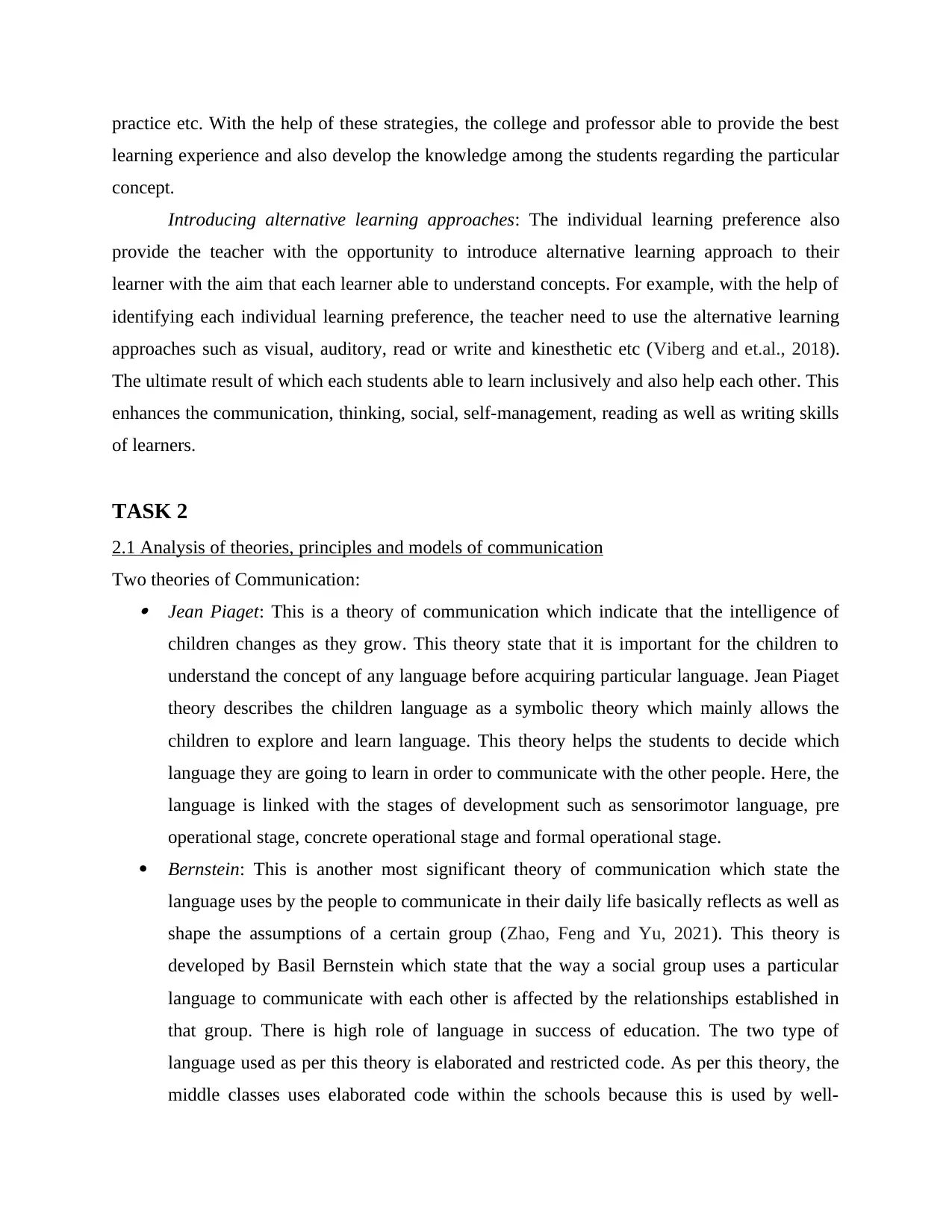
practice etc. With the help of these strategies, the college and professor able to provide the best
learning experience and also develop the knowledge among the students regarding the particular
concept.
Introducing alternative learning approaches: The individual learning preference also
provide the teacher with the opportunity to introduce alternative learning approach to their
learner with the aim that each learner able to understand concepts. For example, with the help of
identifying each individual learning preference, the teacher need to use the alternative learning
approaches such as visual, auditory, read or write and kinesthetic etc (Viberg and et.al., 2018).
The ultimate result of which each students able to learn inclusively and also help each other. This
enhances the communication, thinking, social, self-management, reading as well as writing skills
of learners.
TASK 2
2.1 Analysis of theories, principles and models of communication
Two theories of Communication: Jean Piaget: This is a theory of communication which indicate that the intelligence of
children changes as they grow. This theory state that it is important for the children to
understand the concept of any language before acquiring particular language. Jean Piaget
theory describes the children language as a symbolic theory which mainly allows the
children to explore and learn language. This theory helps the students to decide which
language they are going to learn in order to communicate with the other people. Here, the
language is linked with the stages of development such as sensorimotor language, pre
operational stage, concrete operational stage and formal operational stage.
Bernstein: This is another most significant theory of communication which state the
language uses by the people to communicate in their daily life basically reflects as well as
shape the assumptions of a certain group (Zhao, Feng and Yu, 2021). This theory is
developed by Basil Bernstein which state that the way a social group uses a particular
language to communicate with each other is affected by the relationships established in
that group. There is high role of language in success of education. The two type of
language used as per this theory is elaborated and restricted code. As per this theory, the
middle classes uses elaborated code within the schools because this is used by well-
learning experience and also develop the knowledge among the students regarding the particular
concept.
Introducing alternative learning approaches: The individual learning preference also
provide the teacher with the opportunity to introduce alternative learning approach to their
learner with the aim that each learner able to understand concepts. For example, with the help of
identifying each individual learning preference, the teacher need to use the alternative learning
approaches such as visual, auditory, read or write and kinesthetic etc (Viberg and et.al., 2018).
The ultimate result of which each students able to learn inclusively and also help each other. This
enhances the communication, thinking, social, self-management, reading as well as writing skills
of learners.
TASK 2
2.1 Analysis of theories, principles and models of communication
Two theories of Communication: Jean Piaget: This is a theory of communication which indicate that the intelligence of
children changes as they grow. This theory state that it is important for the children to
understand the concept of any language before acquiring particular language. Jean Piaget
theory describes the children language as a symbolic theory which mainly allows the
children to explore and learn language. This theory helps the students to decide which
language they are going to learn in order to communicate with the other people. Here, the
language is linked with the stages of development such as sensorimotor language, pre
operational stage, concrete operational stage and formal operational stage.
Bernstein: This is another most significant theory of communication which state the
language uses by the people to communicate in their daily life basically reflects as well as
shape the assumptions of a certain group (Zhao, Feng and Yu, 2021). This theory is
developed by Basil Bernstein which state that the way a social group uses a particular
language to communicate with each other is affected by the relationships established in
that group. There is high role of language in success of education. The two type of
language used as per this theory is elaborated and restricted code. As per this theory, the
middle classes uses elaborated code within the schools because this is used by well-
⊘ This is a preview!⊘
Do you want full access?
Subscribe today to unlock all pages.

Trusted by 1+ million students worldwide
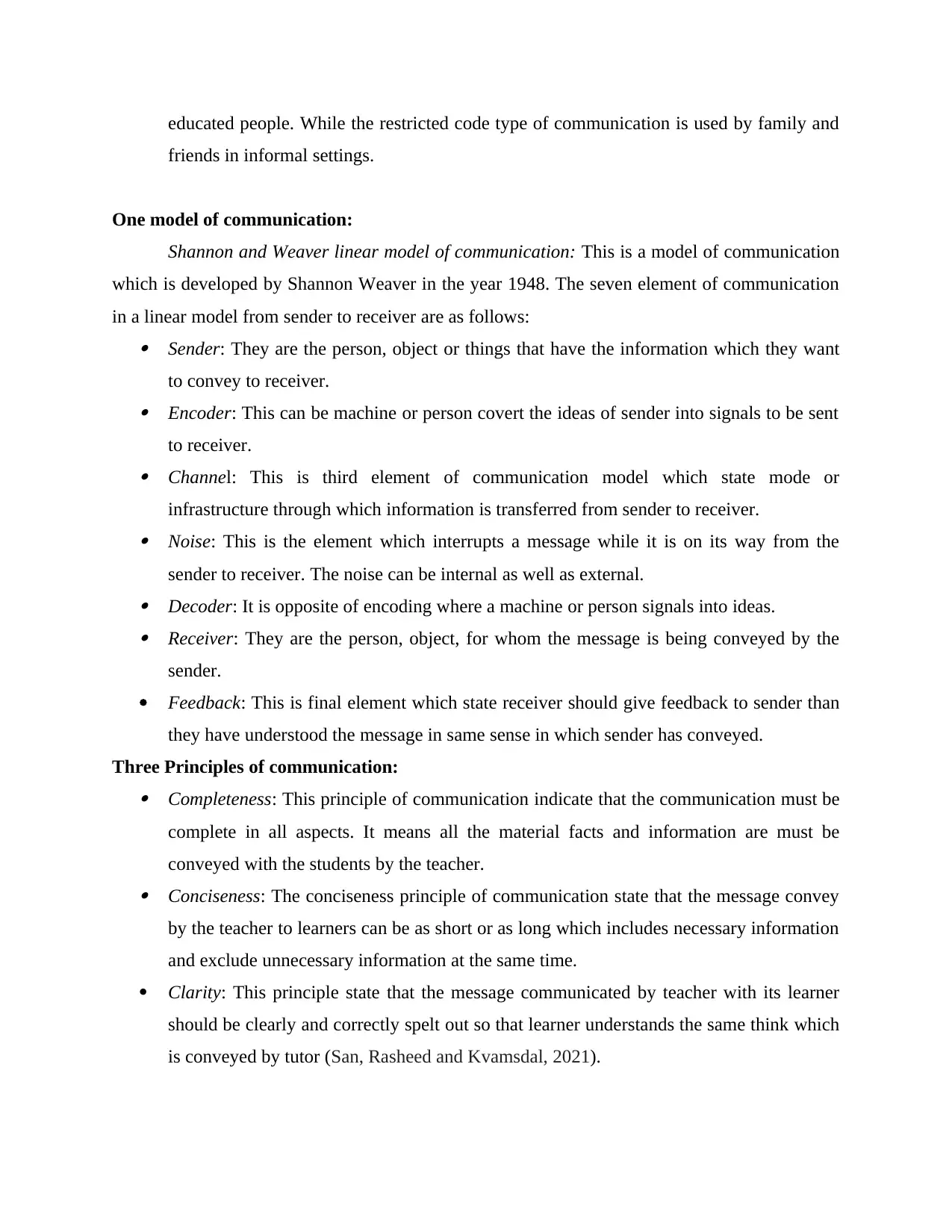
educated people. While the restricted code type of communication is used by family and
friends in informal settings.
One model of communication:
Shannon and Weaver linear model of communication: This is a model of communication
which is developed by Shannon Weaver in the year 1948. The seven element of communication
in a linear model from sender to receiver are as follows: Sender: They are the person, object or things that have the information which they want
to convey to receiver. Encoder: This can be machine or person covert the ideas of sender into signals to be sent
to receiver. Channel: This is third element of communication model which state mode or
infrastructure through which information is transferred from sender to receiver. Noise: This is the element which interrupts a message while it is on its way from the
sender to receiver. The noise can be internal as well as external. Decoder: It is opposite of encoding where a machine or person signals into ideas. Receiver: They are the person, object, for whom the message is being conveyed by the
sender.
Feedback: This is final element which state receiver should give feedback to sender than
they have understood the message in same sense in which sender has conveyed.
Three Principles of communication: Completeness: This principle of communication indicate that the communication must be
complete in all aspects. It means all the material facts and information are must be
conveyed with the students by the teacher. Conciseness: The conciseness principle of communication state that the message convey
by the teacher to learners can be as short or as long which includes necessary information
and exclude unnecessary information at the same time.
Clarity: This principle state that the message communicated by teacher with its learner
should be clearly and correctly spelt out so that learner understands the same think which
is conveyed by tutor (San, Rasheed and Kvamsdal, 2021).
friends in informal settings.
One model of communication:
Shannon and Weaver linear model of communication: This is a model of communication
which is developed by Shannon Weaver in the year 1948. The seven element of communication
in a linear model from sender to receiver are as follows: Sender: They are the person, object or things that have the information which they want
to convey to receiver. Encoder: This can be machine or person covert the ideas of sender into signals to be sent
to receiver. Channel: This is third element of communication model which state mode or
infrastructure through which information is transferred from sender to receiver. Noise: This is the element which interrupts a message while it is on its way from the
sender to receiver. The noise can be internal as well as external. Decoder: It is opposite of encoding where a machine or person signals into ideas. Receiver: They are the person, object, for whom the message is being conveyed by the
sender.
Feedback: This is final element which state receiver should give feedback to sender than
they have understood the message in same sense in which sender has conveyed.
Three Principles of communication: Completeness: This principle of communication indicate that the communication must be
complete in all aspects. It means all the material facts and information are must be
conveyed with the students by the teacher. Conciseness: The conciseness principle of communication state that the message convey
by the teacher to learners can be as short or as long which includes necessary information
and exclude unnecessary information at the same time.
Clarity: This principle state that the message communicated by teacher with its learner
should be clearly and correctly spelt out so that learner understands the same think which
is conveyed by tutor (San, Rasheed and Kvamsdal, 2021).
Paraphrase This Document
Need a fresh take? Get an instant paraphrase of this document with our AI Paraphraser
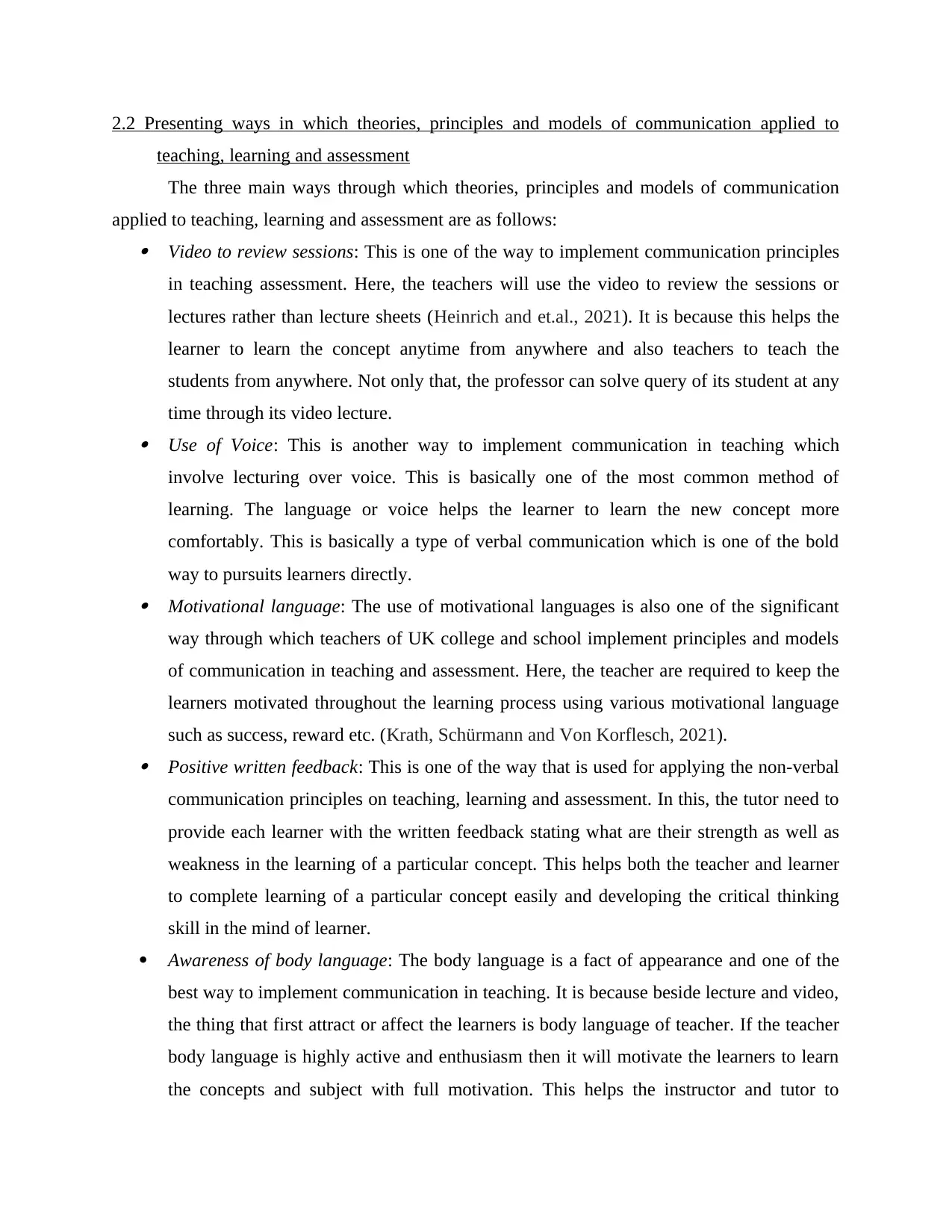
2.2 Presenting ways in which theories, principles and models of communication applied to
teaching, learning and assessment
The three main ways through which theories, principles and models of communication
applied to teaching, learning and assessment are as follows: Video to review sessions: This is one of the way to implement communication principles
in teaching assessment. Here, the teachers will use the video to review the sessions or
lectures rather than lecture sheets (Heinrich and et.al., 2021). It is because this helps the
learner to learn the concept anytime from anywhere and also teachers to teach the
students from anywhere. Not only that, the professor can solve query of its student at any
time through its video lecture. Use of Voice: This is another way to implement communication in teaching which
involve lecturing over voice. This is basically one of the most common method of
learning. The language or voice helps the learner to learn the new concept more
comfortably. This is basically a type of verbal communication which is one of the bold
way to pursuits learners directly. Motivational language: The use of motivational languages is also one of the significant
way through which teachers of UK college and school implement principles and models
of communication in teaching and assessment. Here, the teacher are required to keep the
learners motivated throughout the learning process using various motivational language
such as success, reward etc. (Krath, Schürmann and Von Korflesch, 2021). Positive written feedback: This is one of the way that is used for applying the non-verbal
communication principles on teaching, learning and assessment. In this, the tutor need to
provide each learner with the written feedback stating what are their strength as well as
weakness in the learning of a particular concept. This helps both the teacher and learner
to complete learning of a particular concept easily and developing the critical thinking
skill in the mind of learner.
Awareness of body language: The body language is a fact of appearance and one of the
best way to implement communication in teaching. It is because beside lecture and video,
the thing that first attract or affect the learners is body language of teacher. If the teacher
body language is highly active and enthusiasm then it will motivate the learners to learn
the concepts and subject with full motivation. This helps the instructor and tutor to
teaching, learning and assessment
The three main ways through which theories, principles and models of communication
applied to teaching, learning and assessment are as follows: Video to review sessions: This is one of the way to implement communication principles
in teaching assessment. Here, the teachers will use the video to review the sessions or
lectures rather than lecture sheets (Heinrich and et.al., 2021). It is because this helps the
learner to learn the concept anytime from anywhere and also teachers to teach the
students from anywhere. Not only that, the professor can solve query of its student at any
time through its video lecture. Use of Voice: This is another way to implement communication in teaching which
involve lecturing over voice. This is basically one of the most common method of
learning. The language or voice helps the learner to learn the new concept more
comfortably. This is basically a type of verbal communication which is one of the bold
way to pursuits learners directly. Motivational language: The use of motivational languages is also one of the significant
way through which teachers of UK college and school implement principles and models
of communication in teaching and assessment. Here, the teacher are required to keep the
learners motivated throughout the learning process using various motivational language
such as success, reward etc. (Krath, Schürmann and Von Korflesch, 2021). Positive written feedback: This is one of the way that is used for applying the non-verbal
communication principles on teaching, learning and assessment. In this, the tutor need to
provide each learner with the written feedback stating what are their strength as well as
weakness in the learning of a particular concept. This helps both the teacher and learner
to complete learning of a particular concept easily and developing the critical thinking
skill in the mind of learner.
Awareness of body language: The body language is a fact of appearance and one of the
best way to implement communication in teaching. It is because beside lecture and video,
the thing that first attract or affect the learners is body language of teacher. If the teacher
body language is highly active and enthusiasm then it will motivate the learners to learn
the concepts and subject with full motivation. This helps the instructor and tutor to
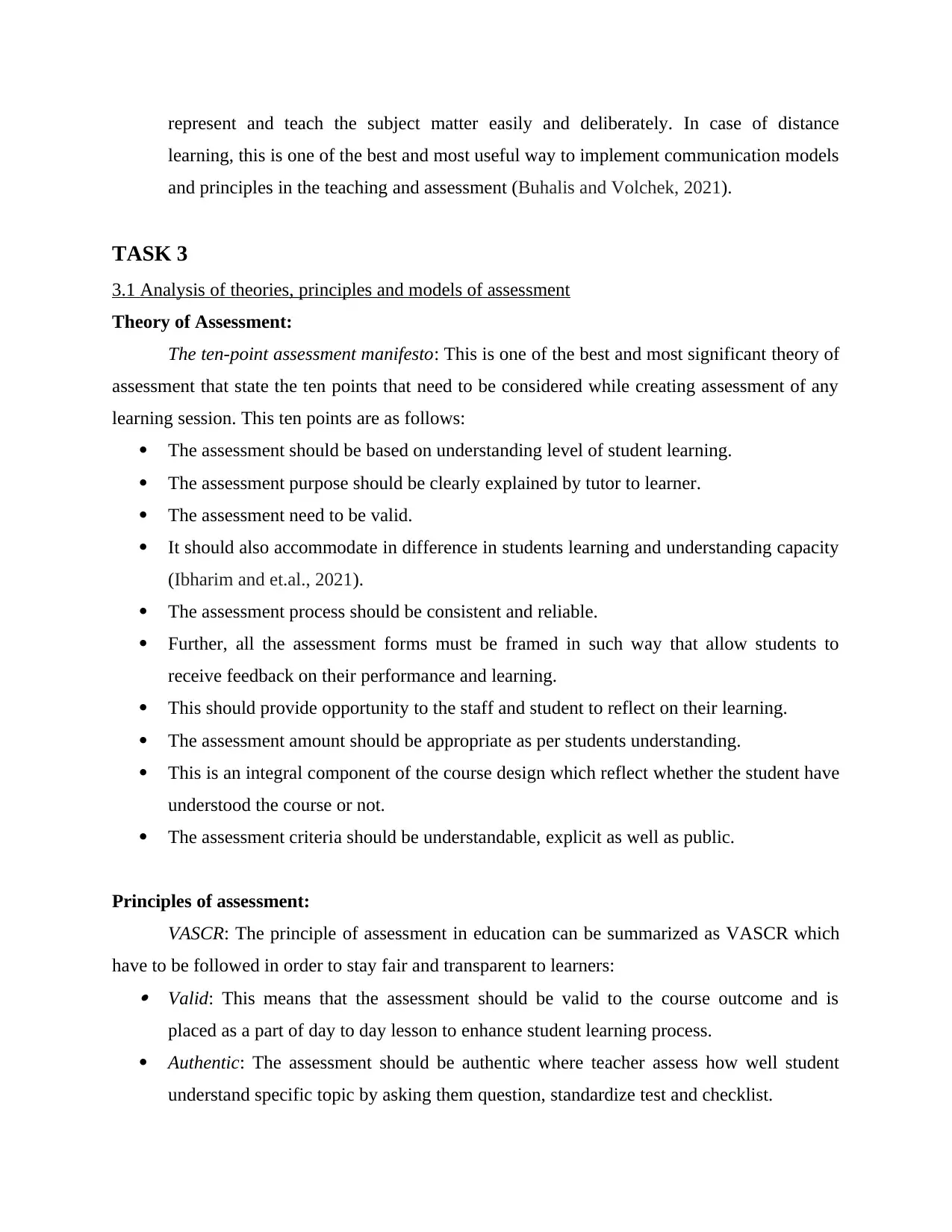
represent and teach the subject matter easily and deliberately. In case of distance
learning, this is one of the best and most useful way to implement communication models
and principles in the teaching and assessment (Buhalis and Volchek, 2021).
TASK 3
3.1 Analysis of theories, principles and models of assessment
Theory of Assessment:
The ten-point assessment manifesto: This is one of the best and most significant theory of
assessment that state the ten points that need to be considered while creating assessment of any
learning session. This ten points are as follows:
The assessment should be based on understanding level of student learning.
The assessment purpose should be clearly explained by tutor to learner.
The assessment need to be valid.
It should also accommodate in difference in students learning and understanding capacity
(Ibharim and et.al., 2021).
The assessment process should be consistent and reliable.
Further, all the assessment forms must be framed in such way that allow students to
receive feedback on their performance and learning.
This should provide opportunity to the staff and student to reflect on their learning.
The assessment amount should be appropriate as per students understanding.
This is an integral component of the course design which reflect whether the student have
understood the course or not.
The assessment criteria should be understandable, explicit as well as public.
Principles of assessment:
VASCR: The principle of assessment in education can be summarized as VASCR which
have to be followed in order to stay fair and transparent to learners: Valid: This means that the assessment should be valid to the course outcome and is
placed as a part of day to day lesson to enhance student learning process.
Authentic: The assessment should be authentic where teacher assess how well student
understand specific topic by asking them question, standardize test and checklist.
learning, this is one of the best and most useful way to implement communication models
and principles in the teaching and assessment (Buhalis and Volchek, 2021).
TASK 3
3.1 Analysis of theories, principles and models of assessment
Theory of Assessment:
The ten-point assessment manifesto: This is one of the best and most significant theory of
assessment that state the ten points that need to be considered while creating assessment of any
learning session. This ten points are as follows:
The assessment should be based on understanding level of student learning.
The assessment purpose should be clearly explained by tutor to learner.
The assessment need to be valid.
It should also accommodate in difference in students learning and understanding capacity
(Ibharim and et.al., 2021).
The assessment process should be consistent and reliable.
Further, all the assessment forms must be framed in such way that allow students to
receive feedback on their performance and learning.
This should provide opportunity to the staff and student to reflect on their learning.
The assessment amount should be appropriate as per students understanding.
This is an integral component of the course design which reflect whether the student have
understood the course or not.
The assessment criteria should be understandable, explicit as well as public.
Principles of assessment:
VASCR: The principle of assessment in education can be summarized as VASCR which
have to be followed in order to stay fair and transparent to learners: Valid: This means that the assessment should be valid to the course outcome and is
placed as a part of day to day lesson to enhance student learning process.
Authentic: The assessment should be authentic where teacher assess how well student
understand specific topic by asking them question, standardize test and checklist.
⊘ This is a preview!⊘
Do you want full access?
Subscribe today to unlock all pages.

Trusted by 1+ million students worldwide
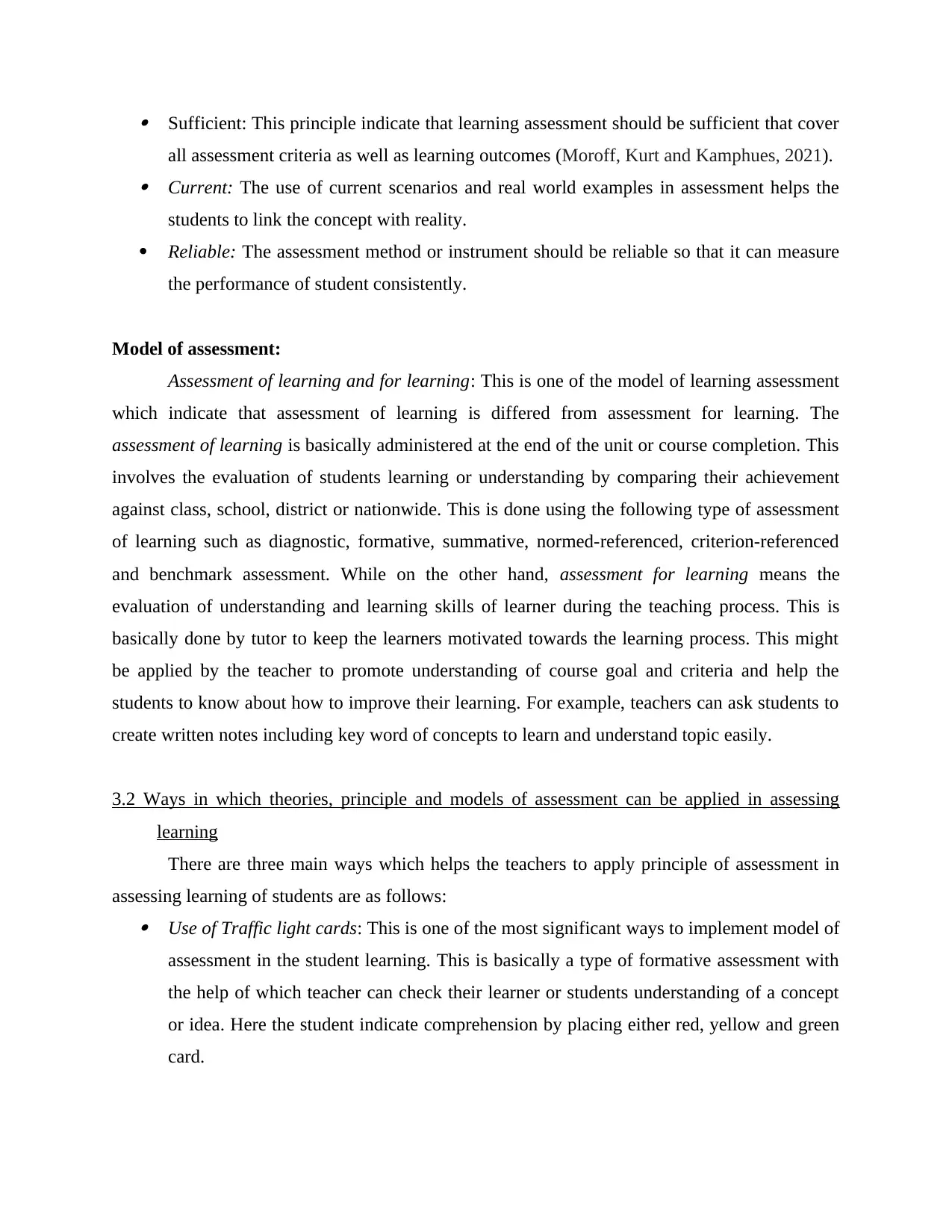
Sufficient: This principle indicate that learning assessment should be sufficient that cover
all assessment criteria as well as learning outcomes (Moroff, Kurt and Kamphues, 2021). Current: The use of current scenarios and real world examples in assessment helps the
students to link the concept with reality.
Reliable: The assessment method or instrument should be reliable so that it can measure
the performance of student consistently.
Model of assessment:
Assessment of learning and for learning: This is one of the model of learning assessment
which indicate that assessment of learning is differed from assessment for learning. The
assessment of learning is basically administered at the end of the unit or course completion. This
involves the evaluation of students learning or understanding by comparing their achievement
against class, school, district or nationwide. This is done using the following type of assessment
of learning such as diagnostic, formative, summative, normed-referenced, criterion-referenced
and benchmark assessment. While on the other hand, assessment for learning means the
evaluation of understanding and learning skills of learner during the teaching process. This is
basically done by tutor to keep the learners motivated towards the learning process. This might
be applied by the teacher to promote understanding of course goal and criteria and help the
students to know about how to improve their learning. For example, teachers can ask students to
create written notes including key word of concepts to learn and understand topic easily.
3.2 Ways in which theories, principle and models of assessment can be applied in assessing
learning
There are three main ways which helps the teachers to apply principle of assessment in
assessing learning of students are as follows: Use of Traffic light cards: This is one of the most significant ways to implement model of
assessment in the student learning. This is basically a type of formative assessment with
the help of which teacher can check their learner or students understanding of a concept
or idea. Here the student indicate comprehension by placing either red, yellow and green
card.
all assessment criteria as well as learning outcomes (Moroff, Kurt and Kamphues, 2021). Current: The use of current scenarios and real world examples in assessment helps the
students to link the concept with reality.
Reliable: The assessment method or instrument should be reliable so that it can measure
the performance of student consistently.
Model of assessment:
Assessment of learning and for learning: This is one of the model of learning assessment
which indicate that assessment of learning is differed from assessment for learning. The
assessment of learning is basically administered at the end of the unit or course completion. This
involves the evaluation of students learning or understanding by comparing their achievement
against class, school, district or nationwide. This is done using the following type of assessment
of learning such as diagnostic, formative, summative, normed-referenced, criterion-referenced
and benchmark assessment. While on the other hand, assessment for learning means the
evaluation of understanding and learning skills of learner during the teaching process. This is
basically done by tutor to keep the learners motivated towards the learning process. This might
be applied by the teacher to promote understanding of course goal and criteria and help the
students to know about how to improve their learning. For example, teachers can ask students to
create written notes including key word of concepts to learn and understand topic easily.
3.2 Ways in which theories, principle and models of assessment can be applied in assessing
learning
There are three main ways which helps the teachers to apply principle of assessment in
assessing learning of students are as follows: Use of Traffic light cards: This is one of the most significant ways to implement model of
assessment in the student learning. This is basically a type of formative assessment with
the help of which teacher can check their learner or students understanding of a concept
or idea. Here the student indicate comprehension by placing either red, yellow and green
card.
Paraphrase This Document
Need a fresh take? Get an instant paraphrase of this document with our AI Paraphraser
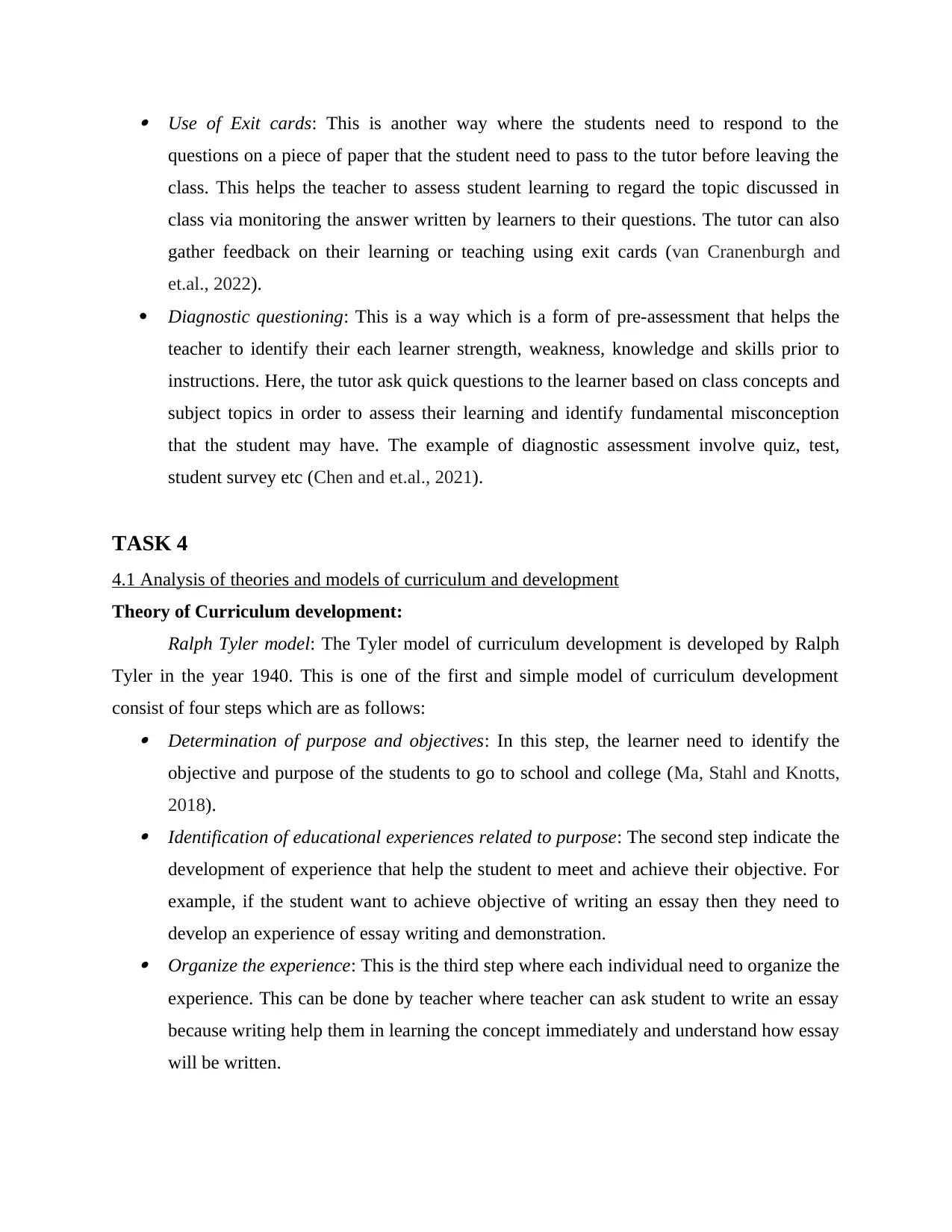
Use of Exit cards: This is another way where the students need to respond to the
questions on a piece of paper that the student need to pass to the tutor before leaving the
class. This helps the teacher to assess student learning to regard the topic discussed in
class via monitoring the answer written by learners to their questions. The tutor can also
gather feedback on their learning or teaching using exit cards (van Cranenburgh and
et.al., 2022).
Diagnostic questioning: This is a way which is a form of pre-assessment that helps the
teacher to identify their each learner strength, weakness, knowledge and skills prior to
instructions. Here, the tutor ask quick questions to the learner based on class concepts and
subject topics in order to assess their learning and identify fundamental misconception
that the student may have. The example of diagnostic assessment involve quiz, test,
student survey etc (Chen and et.al., 2021).
TASK 4
4.1 Analysis of theories and models of curriculum and development
Theory of Curriculum development:
Ralph Tyler model: The Tyler model of curriculum development is developed by Ralph
Tyler in the year 1940. This is one of the first and simple model of curriculum development
consist of four steps which are as follows: Determination of purpose and objectives: In this step, the learner need to identify the
objective and purpose of the students to go to school and college (Ma, Stahl and Knotts,
2018). Identification of educational experiences related to purpose: The second step indicate the
development of experience that help the student to meet and achieve their objective. For
example, if the student want to achieve objective of writing an essay then they need to
develop an experience of essay writing and demonstration. Organize the experience: This is the third step where each individual need to organize the
experience. This can be done by teacher where teacher can ask student to write an essay
because writing help them in learning the concept immediately and understand how essay
will be written.
questions on a piece of paper that the student need to pass to the tutor before leaving the
class. This helps the teacher to assess student learning to regard the topic discussed in
class via monitoring the answer written by learners to their questions. The tutor can also
gather feedback on their learning or teaching using exit cards (van Cranenburgh and
et.al., 2022).
Diagnostic questioning: This is a way which is a form of pre-assessment that helps the
teacher to identify their each learner strength, weakness, knowledge and skills prior to
instructions. Here, the tutor ask quick questions to the learner based on class concepts and
subject topics in order to assess their learning and identify fundamental misconception
that the student may have. The example of diagnostic assessment involve quiz, test,
student survey etc (Chen and et.al., 2021).
TASK 4
4.1 Analysis of theories and models of curriculum and development
Theory of Curriculum development:
Ralph Tyler model: The Tyler model of curriculum development is developed by Ralph
Tyler in the year 1940. This is one of the first and simple model of curriculum development
consist of four steps which are as follows: Determination of purpose and objectives: In this step, the learner need to identify the
objective and purpose of the students to go to school and college (Ma, Stahl and Knotts,
2018). Identification of educational experiences related to purpose: The second step indicate the
development of experience that help the student to meet and achieve their objective. For
example, if the student want to achieve objective of writing an essay then they need to
develop an experience of essay writing and demonstration. Organize the experience: This is the third step where each individual need to organize the
experience. This can be done by teacher where teacher can ask student to write an essay
because writing help them in learning the concept immediately and understand how essay
will be written.
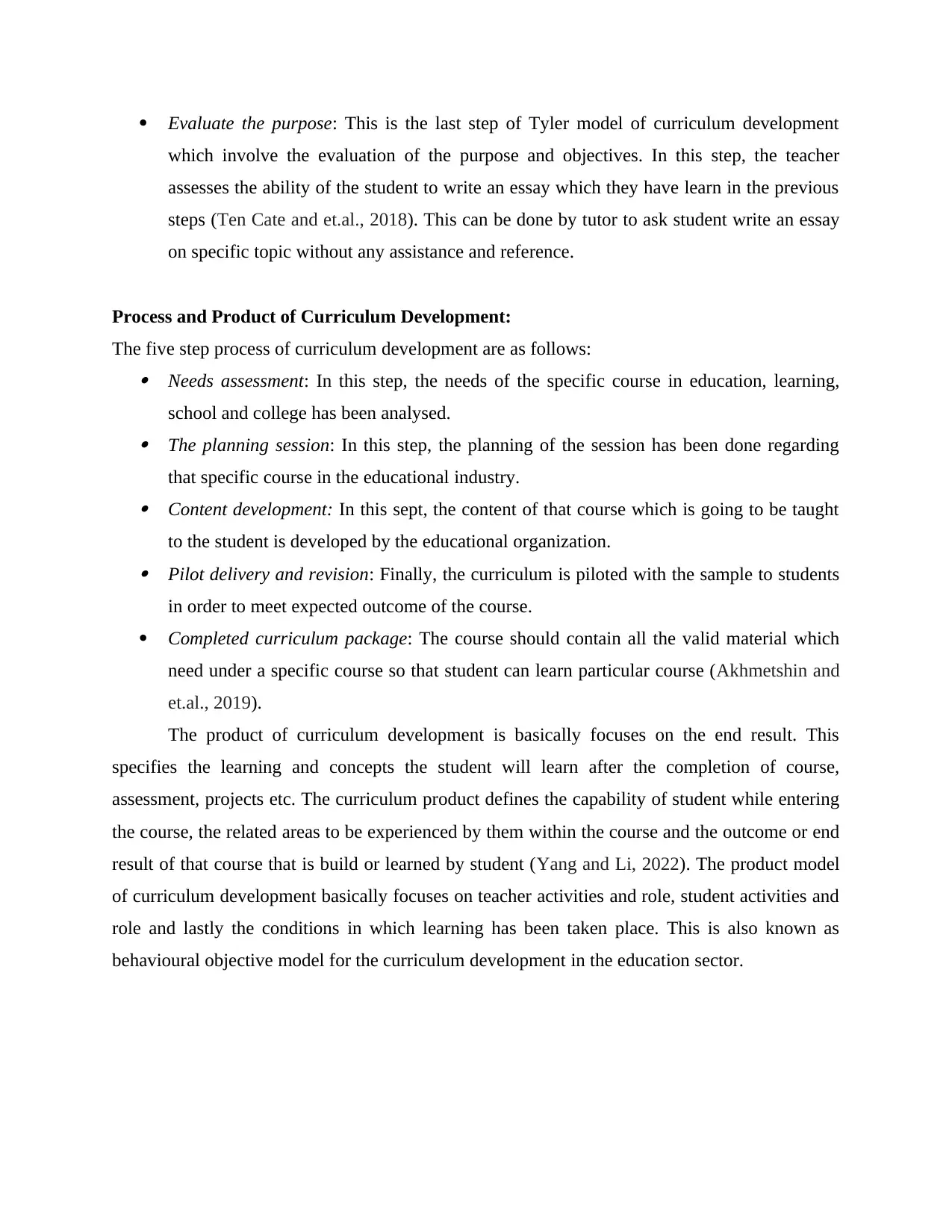
Evaluate the purpose: This is the last step of Tyler model of curriculum development
which involve the evaluation of the purpose and objectives. In this step, the teacher
assesses the ability of the student to write an essay which they have learn in the previous
steps (Ten Cate and et.al., 2018). This can be done by tutor to ask student write an essay
on specific topic without any assistance and reference.
Process and Product of Curriculum Development:
The five step process of curriculum development are as follows: Needs assessment: In this step, the needs of the specific course in education, learning,
school and college has been analysed. The planning session: In this step, the planning of the session has been done regarding
that specific course in the educational industry. Content development: In this sept, the content of that course which is going to be taught
to the student is developed by the educational organization. Pilot delivery and revision: Finally, the curriculum is piloted with the sample to students
in order to meet expected outcome of the course.
Completed curriculum package: The course should contain all the valid material which
need under a specific course so that student can learn particular course (Akhmetshin and
et.al., 2019).
The product of curriculum development is basically focuses on the end result. This
specifies the learning and concepts the student will learn after the completion of course,
assessment, projects etc. The curriculum product defines the capability of student while entering
the course, the related areas to be experienced by them within the course and the outcome or end
result of that course that is build or learned by student (Yang and Li, 2022). The product model
of curriculum development basically focuses on teacher activities and role, student activities and
role and lastly the conditions in which learning has been taken place. This is also known as
behavioural objective model for the curriculum development in the education sector.
which involve the evaluation of the purpose and objectives. In this step, the teacher
assesses the ability of the student to write an essay which they have learn in the previous
steps (Ten Cate and et.al., 2018). This can be done by tutor to ask student write an essay
on specific topic without any assistance and reference.
Process and Product of Curriculum Development:
The five step process of curriculum development are as follows: Needs assessment: In this step, the needs of the specific course in education, learning,
school and college has been analysed. The planning session: In this step, the planning of the session has been done regarding
that specific course in the educational industry. Content development: In this sept, the content of that course which is going to be taught
to the student is developed by the educational organization. Pilot delivery and revision: Finally, the curriculum is piloted with the sample to students
in order to meet expected outcome of the course.
Completed curriculum package: The course should contain all the valid material which
need under a specific course so that student can learn particular course (Akhmetshin and
et.al., 2019).
The product of curriculum development is basically focuses on the end result. This
specifies the learning and concepts the student will learn after the completion of course,
assessment, projects etc. The curriculum product defines the capability of student while entering
the course, the related areas to be experienced by them within the course and the outcome or end
result of that course that is build or learned by student (Yang and Li, 2022). The product model
of curriculum development basically focuses on teacher activities and role, student activities and
role and lastly the conditions in which learning has been taken place. This is also known as
behavioural objective model for the curriculum development in the education sector.
⊘ This is a preview!⊘
Do you want full access?
Subscribe today to unlock all pages.

Trusted by 1+ million students worldwide
1 out of 19
Related Documents
Your All-in-One AI-Powered Toolkit for Academic Success.
+13062052269
info@desklib.com
Available 24*7 on WhatsApp / Email
![[object Object]](/_next/static/media/star-bottom.7253800d.svg)
Unlock your academic potential
Copyright © 2020–2025 A2Z Services. All Rights Reserved. Developed and managed by ZUCOL.



